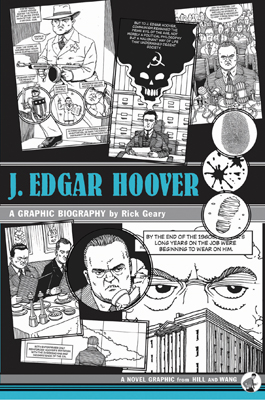home | metro santa cruz index | the arts | visual arts | review

Days of infamy: Graphic artist Rick Geary's new book examines the life and times of J. Edgar Hoover.
Turning Point
Two graphic works of nonfiction explore the Hoover years and the Students for a Democratic Society.
By Richard von Busack
The able and intelligent Rick Geary is a caricaturist in the same sense that Flaubert was a writer of sketches. Geary's art is restrained but sardonic. He is handy with quiet scenes of domestic life. In his new book, J. Edgar Hoover: A Graphic Biography, note a drawing of Hoover's pets, a pair of Cairn terriers: impassive, ominous, with ratlike black eyes. And yet there's plenty of graphic punch in Geary's depiction of the death of John Dillinger. This isn't a hatchet job, although Geary is summing up the life of one of the most arrogant and sinister figures in American history. There's a muted sense of admiration for Hoover's "indomitable will," which decayed over the years into a secret-policeman's paranoia.
Head of the Justice Department's Investigation Bureau by age 29, Hoover, a lifelong Washington insider, used both painstaking detective work and a thirst for personal publicity to keep him heading the FBI through six presidencies. A ghost-written bestseller in the 1950s revived Hoover's reputation as a 1930s crimebuster. While Hoover ended the careers of numerous Depression-era gangsters, he also was blind to organized crime.
Hoover's COINTELPRO program (1956-1971) brought totalitarian methods to the United States. Martin Luther King Jr. was among the famous victims of Hoover's anonymous letters, buggings and harassment. As for Hoover's personal life: Geary is too correct a biographer to endorse the legend that Hoover's bosom friend Clyde Tolson was more than "a longtime companion" in the fraternal sense of the term.
Hoover makes a guest appearance in Harvey Pekar and Gary Dumm's Students for a Democratic Society: A Graphic History; the FBI director once denounced the group as "self-deluded liberals and radicals." Dumm and Pekar agree with the "liberals and radicals" part and occasionally with the self-deluded part as well.
The political 1960s could be said to have begun at a United Auto Workers summer camp in Port Huron, Mich. In 1962, a group of student activists drafted a platform of ideals that began the decade's most powerful student organization. Protests, riots and schisms galore followed. Much of the book is given to denouncing the Progressive Labor party: earnest, suit-clad Maoists who declined to partake in the sex, drugs and rock & roll that made all of this political organizing colorful.
The personal histories are more compelling than the political histories; when this book goes into first-person accounts, Dumm and Pekar are working in a field that's served them well over the years. Highlights are the Terkel-style narratives: Paul Buhle's story of getting out of the Army is a lesson for young people who might face a revived draft someday. Nick Thorkelson's account of the mining strike in Hazard, Ky., is as funny as it is valuable, and so is Sandy Lillydahl's story of emerging feminism within the SDS.
Santa Cruz's Wes Modes illustrates two violent moments in the days of student activism: the massacre at Kent State and the Weather Underground's participation in the November 1969 riots in Washington. Penelope Rosemont, once a radical publisher, quotes her own left-wing grandfather's rules for living: "Never join the National Guard, you might have to kill your brother," and "You're not a real American until you've seen jail from the inside."
J. EDGAR HOOVER: A GRAPHIC BIOGRAPHY by Rick Geary; Hill and Wang; 102 pages; $16.95 cloth. STUDENTS FOR A DEMOCRATIC SOCIETY: A GRAPHIC HISTORY by Harvey Pekar, Gary Dumm and others, edited by Paul Buhle; Hill and Wang; 212 pages; $22 cloth.
Send a letter to the editor about this story.
|
|
|
|
|
|